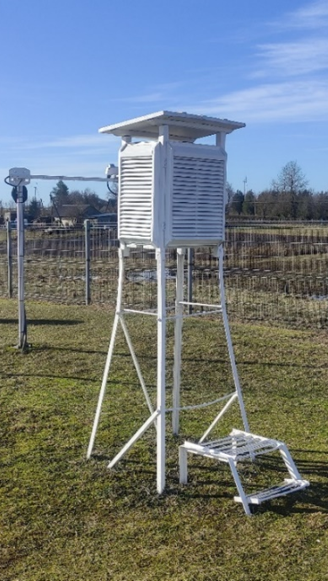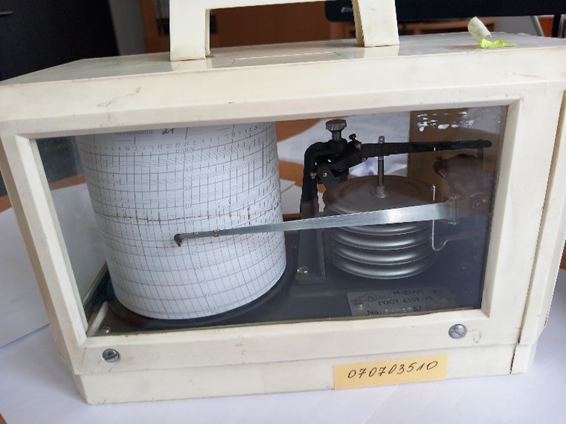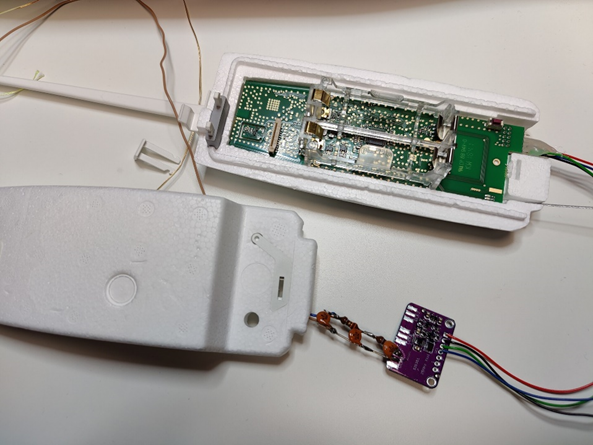Weather station

In Lithuania, consistent and long-term measurements have been conducted for more than 250 years. During this period, meteorological stations have continuously evolved – from mercury thermometers for measuring air temperature to tiny sensors capable of measuring not only air temperature but also relative humidity. We invite you to explore some of the measuring instruments used and currently in use at the Lithuanian Hydrometeorological Service (LHMS) meteorological stations.
Psychrometric cage (Stevenson screen) – historical measurements

The Psychrometric cage or Stevenson screen was one of the main instruments used in meteorological stations. Its purpose was to protect the instruments inside from direct sunlight and rain while allowing air to circulate freely.
Inside the cage, glass thermometers were kept (for measuring average, maximum, and minimum air temperatures), along with a stationary psychrometer and hygrograph (devices used to measure air humidity).
The cage was mounted on a high frame to ensure that the air temperature was measured at a standard height of 1.5 meters.
The maximum air temperature thermometer inside the cage was positioned almost horizontally, and the constriction in the thermometer’s capillary prevented the mercury column from returning.
The minimum temperature thermometer recorded the lowest temperature when the alcohol in the capillary would push a small float downward. As the temperature rose, the float would remain at the lowest point reached.
Psychrometric cages can still be found at some LHMT meteorological stations. However, in all meteorological stations, air temperature is now measured with an automatic air temperature and relative humidity sensor
Barograph – historical measurements

A barograph – is a device designed for the continuous recording of atmospheric pressure. The sensor of the device is a vacuum aneroid box, known as a baroblock. This sensor is connected to a pointer, and a pen filled with ink marks the atmospheric pressure values on a special barogram (typically a weekly or, much less frequently, a daily chart). As the barogram’s drum is rotated by a clockwork mechanism, the pen draws a line that reflects the changes in atmospheric pressure. The barogram allows meteorologists to predict the weather based on pressure trends. For instance, if a cyclone is approaching, the pressure will drop.
This device was kept in the meteorological station premises. Barographs were phased out in meteorological stations as early as 2011 and were replaced by automatic pressure measurement sensors.
Combined air temperature and relative humidity automatic sensor with solar protection – modern measurements

Air temperature and relative humidity sensor – the air temperature is measured using a platinum resistance thermometer, while relative humidity is measured with a polymer sensor. The operation of resistance thermometers is based on the relationship between the resistance of metals and semiconductors and their temperature. This single sensor measures the average, maximum, and minimum air temperature, relative humidity, records the minimum relative humidity value, and can also calculate the dew point temperature, as well as the minimum dew point temperature. The average air temperature is automatically measured every 10 seconds, and the average value for 10 minutes is calculated from these readings.
The solar protection is necessary to prevent direct sunlight from affecting the sensor’s measurements, and the unique design of this protection allows air to circulate freely around the sensor (you can compare how temperature measurement devices have changed over time)
Such uniquely designed devices can be found not only in LHMT meteorological stations in Lithuania but also in roadside meteorological stations installed along highways.
Radiosonde – modern measurements

Radiosonde is a device used to measure meteorological parameters of the vertical atmospheric layers, such as air temperature, relative humidity, atmospheric pressure, wind speed, and direction, from the Earth’s surface up to the lower stratosphere (about 30 km in altitude). As the balloon rises, it expands and eventually bursts due to the thinning of the atmosphere.
In Lithuania, meteorological balloons with radiosondes are regularly launched every night (at 00:00 UTC – 2 AM during wintertime, 3 AM during summertime) from the Kaunas Meteorological Station. The hydrogen-filled meteorological balloon carries a small white box, the radiosonde, which weighs nearly the same as a smartphone. As it ascends, the radiosonde measures atmospheric parameters and automatically generates an aerological diagram. This data provides valuable information about atmospheric conditions at various altitudes and plays a crucial role in weather forecasting, especially digital forecasts, as well as in aviation. In aviation, these measurements are used to assess meteorological conditions and help predict wind speed, direction, turbulence, and other hazards, ensuring safe flights and facilitating flight planning.
You can watch how the radiosonde is launched from the Kaunas Meteorological Station here:
“Radijo klubo” video (from 5:26 to 8:57 minutes)

Anemometer (cup anemometer with wind vane) – modern measurements


Anemometer – on one side of the crossbar, a four-cup anemometer is mounted to measure wind speed, while the wind vane on the other side automatically records wind direction. The device takes measurements every second, from which 10-minute averages are calculated, or the maximum wind speed and direction values and wind gusts are selected. This device was used at LHMS meteorological stations until 2021, after which it was replaced by measurements using a more accurate ultrasonic wind speed and direction sensor technology
Handheld Anemometer – Historical Measurements

Handheld Anemometer – This device is designed to measure the average wind speed and features four cup-shaped rotors. When the wind acts on the metal or plastic sensors in the shape of cups or blades, it causes them to rotate around their axis, with the rotational speed being proportional to the wind speed. During measurements, the device must be held in hand vertically or attached on stable profile. When held by the hand, the wind should blow towards the user’s face. This device is no longer found in LHMT meteorological stations.